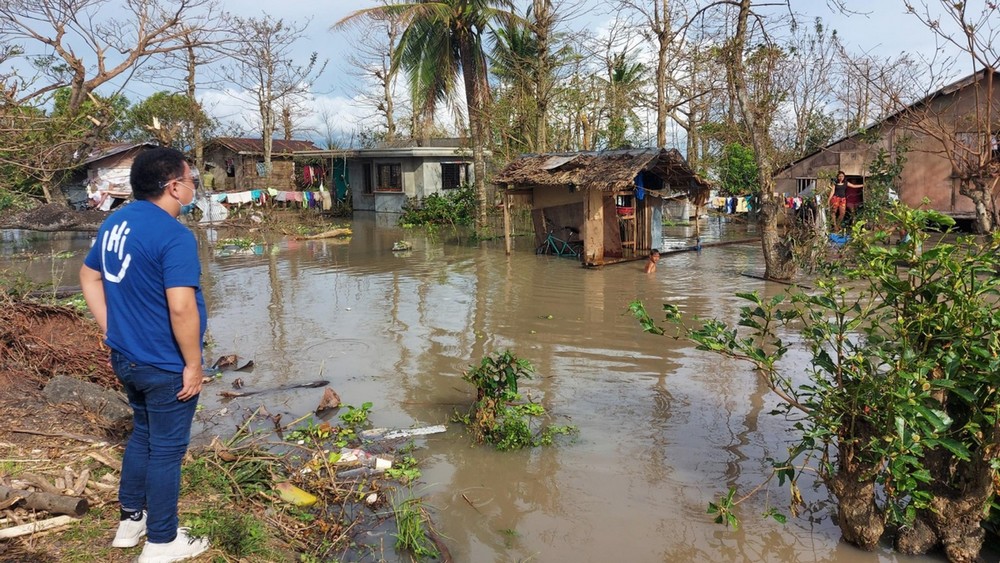share
HI attends COP26 and calls on States to include people with disabilities in disaster risk reduction and climate action protocol.
Due to climate change, the number of disasters related to natural hazards has increased fivefold over the past 50 years. Since 1970, more than 11,000 weather, climate, and water-related disasters have occurred, causing more than 2 million deaths and $3.64 billion in economic losses.
In a 2013 global survey, only 20% of people with disabilities reported being able to evacuate disaster-affected areas without difficulty; 71% reported having no emergency preparedness plan; 50% said they wanted to be involved in disaster risk reduction efforts.
People with disabilities are rarely included in disaster preparedness. A UN survey of 5,450 people with disabilities in 126 countries found that only 17% were aware of disaster management plans in their communities, and only 14% had been consulted about them. People in wheelchairs or with other mobility aids cannot access evacuation routes or shelters. People with visual disabilities are not provided with adapted risk education materials. This neglect means that people with disabilities are often left behind when disasters occur.
The effects of climate change, including climate-induced disasters, are even more severe for people who experience multiple forms of marginalization and exclusion based not only on disability, but also on gender and age. Climate change has a negative impact on the lives, health, well-being and economic status of people with disabilities. Extreme weather or temperatures can result in the loss of livelihoods, shelter and food security, affecting populations long after the event has occurred. Malnutrition and undernutrition resulting from agricultural deterioration and drought can lead to developmental delays or disabilities in children. After a disaster, there is an increase in the number of people developing physical, sensory, and psychosocial disabilities. It is estimated that for every death in a disaster, three more people are injured or disabled.
"HI has a strong presence in our countries of intervention, where its teams implement projects directly with communities. By participating in COP26, we want to bring the point of view of an NGO specializing in disability and inclusion, and who can testify to the impacts of climate change in the field and what this means for vulnerable groups. We will then be able to share our experience and recommendations for addressing it. Throughout the disaster risk management project cycle, there is a lot of room to strengthen the inclusion of people with disabilities. First, we need to make sure we have representatives from all groups, and then meaningfully promote their participation. Organizations don't always proactively seek to include people with disabilities, the elderly or isolated women. Evacuation plans rarely take into account people with limited mobility. Shelters are often inaccessible to people in wheelchairs. If we don't include people from the beginning, we miss opportunities to save lives."
Jennifer M'Vouama, Disaster Risk Reduction and Climate Change Policy Advocacy Officer at HI.
By participating in various COP26 events, HI is advocating for:
On Friday 5 November, HI spoke alongside CBM UK at the event "An inclusive planet: inclusion, mental health and climate change".
The event aimed to highlight the impact of climate change on the health and well-being of people with disabilities, advocate for climate change action to include the participation of people with disabilities, offer suggestions for inclusive resilience measures, and promote an inclusive approach to climate action.
This conference was live-streamed on the COP26YouTube channel.
HI brings unique expertise in inclusive humanitarian action and disaster risk reduction to a wide range of very different global contexts.
Decades of experience working alongside communities and people with disabilities have contributed to the development of a body of knowledge and practice that ensures the meaningful participation and inclusion of vulnerable populations and people with disabilities in emergency preparedness and response.
Currently, HI carries out disaster risk reduction actions in 15 countries and humanitarian projects in 46 others. The organization aims to share its inclusive practices with other international actors and improve its understanding of how vulnerability is exacerbated by climate change to ensure that no one is left behind.








HI is an independent and impartial aid organisation working in situations of poverty and exclusion, conflict and disaster. We work alongside people with disabilities and vulnerable populations, taking action and bearing witness in order to respond to their essential needs, improve their living conditions and promote respect for their dignity and fundamental rights.
HI is an independent and impartial aid organisation working in situations of poverty and exclusion, conflict and disaster. We work alongside people with disabilities and vulnerable populations, taking action and bearing witness in order to respond to their essential needs, improve their living conditions and promote respect for their dignity and fundamental rights.